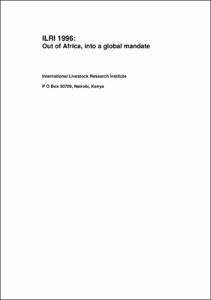Resource information
ILRI's mandate encompasses international livestock research through the developing world. This report makes the connection between research by ILRI and its partners and the needs of poor farmers in developing countries. The assessment of Asian animal agriculture indicates that the most significant and sustainable increases in livestock production are likely to come from mixed crop-livestock systems in rainfed and irrigated areas in South Asia. The research priorities identified includes the nutritional evaluation of novel feed resources and their integration into the farming system, impact and risk assessment of animal health interventions, and characterization and use of resistant genotypes in livestock breeding programmes. Seven articles are presented in this report. ILRI's research on a vaccine to protect smallholder's livestock from the ravages of the disease East Coast fever began in the 1980s. ILRI is ready to take the product of this research out of the laboratories and into farmers' fields. ILRI's research in molecular genetics is providing another technology to move out of the laboratory and into the field. The articles on market-oriented smallholder dairying and the Small Ruminant Research Network focus on ILRI's partnerships with national agricultural research systems, which help move research results out of research and into extension. The article. `The grass is always greener...' brings together results from several areas of research ranging from DNA fingerprinting to field trials of grass varieties adapted to widely differing ecozones and production systems. The article `Forage legumes boost livestock and crop production` is also on taking forages out of the gene bank and into farmers' fields: The final article `Importance of assessing true credit constraint' illustrates the need to move out of economic theory and into practical application.



